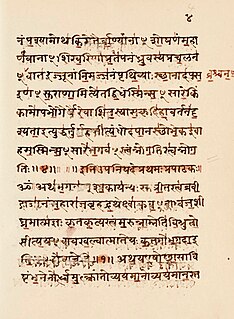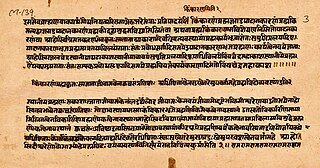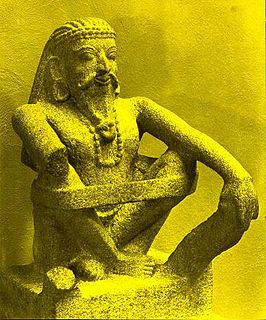
The Upanishads are late Vedic Sanskrit texts of Hindu philosophy which supplied the basis of later Hindu philosophy. They are the most recent part of the Vedas, the oldest scriptures of Hinduism, and deal with meditation, philosophy, consciousness and ontological knowledge; other parts of the Vedas deal with mantras, benedictions, rituals, ceremonies, and sacrifices. While among the most important literature in the history of Indian religions and culture, the Upanishads document a wide variety of "rites, incarnations, and esoteric knowledge" departing from Vedic ritualism and interpreted in various ways in the later commentarial traditions. Of all Vedic literature, the Upanishads alone are widely known, and their diverse ideas, interpreted in various ways, informed the later traditions of Hinduism.
Hindu texts are manuscripts and voluminous historical literature which are related to any of the diverse traditions within Hinduism. A few of these texts are shared across these traditions and they are broadly considered Hindu scriptures. These include the Puranas, Itihasa and Vedas. Scholars hesitate in defining the term "Hindu scriptures" given the diverse nature of Hinduism, but many list the Bhagavad Gita and the Agamas as Hindu scriptures, and Dominic Goodall includes Bhagavata Purana and Yajnavalkya Smriti in the list of Hindu scriptures as well.

The Maitrayaniya Upanishad is an ancient Sanskrit text that is embedded inside the Yajurveda. It is also known as the Maitri Upanishad, and is listed as number 24 in the Muktika canon of 108 Upanishads.

The Isha Upanishad is one of the shortest Upanishads, embedded as the final chapter (adhyāya) of the Shukla Yajurveda. It is a Mukhya Upanishad, and is known in two recensions, called Kanva (VSK) and Madhyandina (VSM). The Upanishad is a brief poem, consisting of 17 or 18 verses, depending on the recension.

The Māṇḍūkya Upaniṣad is the shortest of all the Upanishads, and is assigned to Atharvaveda. It is listed as number 6 in the Muktikā canon of 108 Upanishads.

The Shvetashvatara Upanishad is an ancient Sanskrit text embedded in the Yajurveda. It is listed as number 14 in the Muktika canon of 108 Upanishads. The Upanishad contains 113 mantras or verses in six chapters.
Muktikā refers to the Sanskrit language anthology of a canon of 108 Upaniṣhads. The date of composition of each is unknown, with the oldest probably from about 800 BCE. The Principal Upanishads were composed in the 1st millennium BCE, most Yoga Upanishads composed probably from the 100 BCE to 300 CE period, and seven of the Sannyasa Upanishads composed before the 3rd century CE.
The Kaushitaki Upanishad is an ancient Sanskrit text contained inside the Rigveda. It is associated with the Kaushitaki shakha, but a Sāmānya Upanishad, meaning that it is "common" to all schools of Vedanta. It was included in Robert Hume's list of 13 Principal Upanishads, and lists as number 25 in the Muktika canon of 108 Upanishads.
Principal Upanishads, also known as Mukhya Upanishads, are the most ancient and widely studied Upanishads of Hinduism. Composed between 800 BCE to the start of common era, these texts are connected to the Vedic tradition.

Dhyāna in Hinduism means contemplation and meditation. Dhyāna is taken up in Yoga practices, and is a means to samadhi and self-knowledge.
Aruni, also referred to as Uddalaka or Uddalaka Aruni or Uddalaka Varuni, is a revered Vedic sage of Hinduism. He is mentioned in many Vedic era Sanskrit texts, and his philosophical teachings are among the center piece in the Brihadaranyaka Upanishad and Chandogya Upanishad, two of the oldest Upanishadic scriptures. A famed Vedic teacher, Aruni lived a few centuries before the Buddha, and attracted students from far regions of the Indian subcontinent; some of his students such as Yajnavalkya are also highly revered in the Hindu traditions. Both Aruni and Yajnavalkya are among the most frequently mentioned Upanishadic teachers in Hinduism.

In Hinduism, Brahman connotes the highest universal principle, the ultimate reality in the universe. In major schools of Hindu philosophy, it is the material, efficient, formal and final cause of all that exists. It is the pervasive, infinite, eternal truth and bliss which does not change, yet is the cause of all changes. Brahman as a metaphysical concept refers to the single binding unity behind diversity in all that exists in the universe.
Ratha Kalpana is a metaphor used in Hindu scriptures to describe the relationship between the senses, mind, intellect and the Self. The metaphor was first used in the Katha Upanishad and is thought to have inspired similar descriptions in the Bhagavad Gita, the Dhammapada and Plato's Phaedrus. Gerald James Larson, a scholar of Indian philosophies, believes that the chariot metaphor contains one of the earliest references to ideas and terminology of the Indian philosophical school Samkhya.

The Mantrika Upanishad is a minor Upanishad of Hinduism. The Sanskrit text is one of the 22 Samanya Upanishads, is part of the Vedanta and Yoga schools of Hindu philosophy literature, and is one of 19 Upanishads attached to the Shukla Yajurveda. In the Muktika canon, narrated by Rama to Hanuman, it is listed at number 32 in the anthology of 108 Upanishads.

The Bahvricha Upanishad is a medieval era Sanskrit text and one of the minor Upanishads of Hinduism. It is classified as one of the eight Shakta Upanishads and attached to the Rigveda.
Yoga Upanishads are a group of minor Upanishads of Hinduism related to Yoga. There are twenty Yoga Upanishads in the anthology of 108 Upanishads listed in the Muktika anthology.. The Yoga Upanishads, along with other minor Upanishads, are generally classified separate from the thirteen major Principal Upanishads considered to be more ancient and from the Vedic tradition.
Shakta Upanishads are a group of minor Upanishads of Hinduism related to the Shaktism theology of a Goddess (Devi) as the Supreme Being. There are 8 Shakta Upanishads in the Muktika anthology of 108 Upanishads. They, along with other minor Upanishads, are generally classified separate from the thirteen major Principal Upanishads considered to be from the ancient Vedic tradition.
The Vaishnava Upanishads are minor Upanishads of Hinduism, related to Vishnu theology (Vaishnavism). There are 14 Vaishnava Upanishads in the Muktika anthology of 108 Upanishads. They, along with other minor Upanishads, are generally classified separate from the thirteen major Principal Upanishads considered to be more ancient and from the Vedic tradition.
The Shaiva Upanishads are minor Upanishads of Hinduism, specific to Shiva theology (Shaivism). There are 14 Shaiva Upanishads in the Muktika anthology of 108 Upanishads. They, along with other minor Upanishads, are generally classified separate from the thirteen ancient Principal Upanishads rooted in the Vedic tradition.
Sannyasa Upanishads are a group of minor Upanishads of Hinduism related to the renunciation, monastic practice and asceticism. There are 19 Sannyasa Upanishads in the Muktika anthology of 108 Upanishads. They, along with other minor Upanishads, are generally classified separately from the thirteen major Principal Upanishads considered to be from the ancient Vedic tradition.










